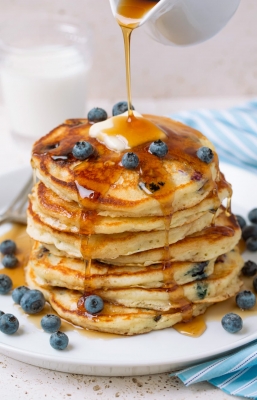
Origin
Pancake-like dishes have been around since pre-historic times, suggest a few studies. Researchers were able to trace starch grains on 30,000-year-old cooking tools suggesting the presence of hotcakes made from cattail (a perennial plant) and fern flour. Some also believe that traces of ground einkorn wheat was a part of Otzi the Iceman’s (5,300-year-old natural mummy) diet. Bits of charcoal were identified while studying his last meals and this reveal the flour was in the form of a pancake, cooked over an open fire.
Pancakes have been prepared across the globe in various forms to suit local preferences. For instance, ancient Greeks and Romans ate pancakes with honey, and the English people ate them with spices, rosewater, sherry and apples in the Elizabethan era. Pancakes were also made in American colonies and were known by various names such as hoe cakes, johnnycakes or flapjacks. Most of these American variants were made with buckwheat or cornmeal. Pancakes were famous not just in the western world, the now-trending Japanese soufflé pancake is believed to have been prepared since the 16th century.
Healthy choices
From gluten-free to vegan, there are pancakes for those who follow particular diets. There are many varieties of pancakes for those who prefer eating clean. Animals milk can be replaced with plant-based milk and mashed fruits such as bananas could also be added. Pancakes can be made without refined flour and eggs as well. A few alternative options would be almond flour, oatmeal, ground chickpeas or cotton cheese.
Flatter than a pancake?
The phrase “flatter than a pancake” has been in use since the 16th century. It is usually used to define flat terrains, where there are typically no hills. For example, Kansas, the U.S. In 2003, a recurrent comparison of Kansas and pancake led three geographers to attempt to determine the relative flatness of pancakes and Kansas. The observations of the study stated that Kansas is even flatter than a pancake.
Get set, flip!
Have you heard of pancakes races? These races have been popular for centuries and is an iconic event on Pancake Day, also known as the feast day of Shrove Tuesday. This occasion also has a religious significance, as it’s the final day before Lent begins. The pancake race is generally a relay where the team members run the length of a track, flipping their pancakes on a pan.
Get artistic
Pancake art is taking the Internet by storm. Pancake artists have been creating stunning artwork, with the frying pan as the canvas and coloured pancake batter as the medium. The artwork is created with the coloured batter laid down first, over which the non-coloured pancake batter is poured.
Picture Credit : Google




